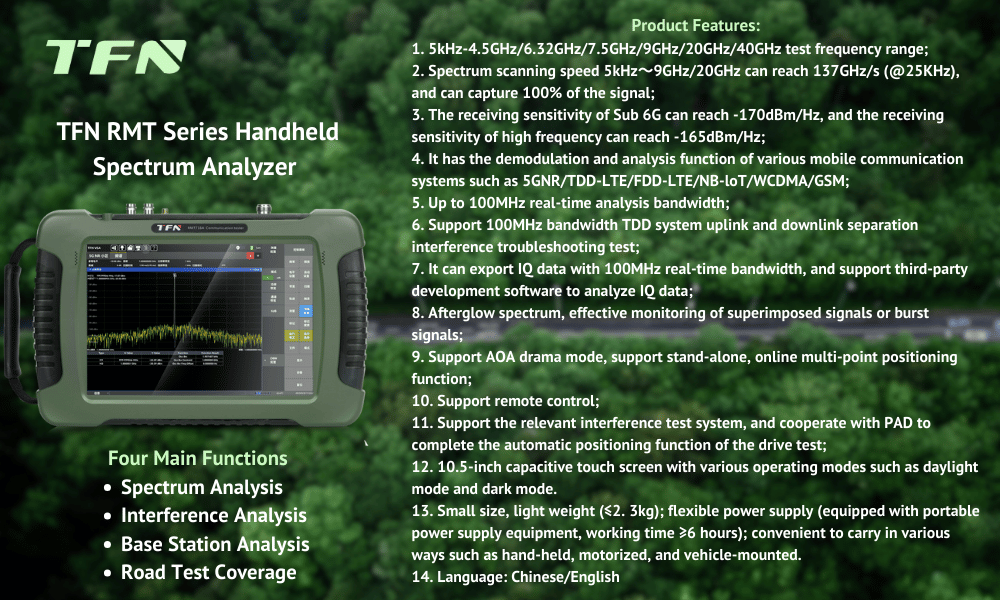How to detect walkie-talkie signals with a spectrum analyzer?
As a communication tool with strong real-time performance, high convenience and low cost, walkie-talkies are widely used in various occasions, such as construction sites, security, logistics, etc. However, in some cases, we may need to detect walkie-talkie signals, such as signal interference troubleshooting or spectrum management. At this time, the spectrum analyzer becomes an important tool.
The spectrum analyzer is an instrument for studying the spectrum structure of electrical signals, which is used to measure parameters such as signal distortion, modulation, spectral purity, frequency stability and intermodulation distortion. It can analyze electrical signals in all radio frequency bands from very low frequency to submillimeter wave bands, and display the analysis results in analog or digital form. The following will introduce in detail how to detect walkie-talkie signals with a spectrum analyzer.
1. Preparation
1.1 Select a suitable spectrum analyzer: Select a suitable spectrum analyzer according to the frequency range, bandwidth and measurement accuracy requirements of the walkie-talkie signal. Walkie-talkies usually work in the VHF (very high frequency) or UHF (ultra-high frequency) bands, so choose a spectrum analyzer that can cover these bands.
1.2 Set the parameters of the spectrum analyzer
Center frequency: set to the center frequency of the walkie-talkie signal.
Scan bandwidth: cover the frequency range of the walkie-talkie signal.
Resolution bandwidth (RBW): determined according to the bandwidth of the signal and the measurement accuracy requirements. A lower RBW helps to distinguish signals of different frequencies, but may cause signal display distortion; a higher RBW helps detect wideband signals, but may increase the noise floor value and reduce measurement sensitivity.
Video bandwidth (VBW): usually set to a value close to the RBW to optimize signal display.
1.3 Prepare measurement accessories: In open-circuit measurements, use measurement antennas and signal amplifiers; in closed-circuit measurements, use attenuators, connectors (adapters), filters, and test cables.
2. Operation Steps
2.1 Connect the measurement antenna: Connect the measurement antenna to the input interface of the spectrum analyzer. If the antenna interface is inconsistent with the interface of the spectrum analyzer, use a converter to connect. Select a suitable measurement antenna, such as a dipole antenna, logarithmic antenna, etc., according to the frequency and measurement requirements of the walkie-talkie signal.
2.2 Turn on the spectrum analyzer: Turn on the power of the spectrum analyzer and wait for the instrument to stabilize. Adjust the display interface of the spectrum analyzer according to the parameters set previously.
2.3 Perform signal detection: On the display screen of the spectrum analyzer, observe whether there is a spectrum display of the walkie-talkie signal. If the signal is weak, a signal amplifier can be used to enhance the signal strength; if you need to track, interfere or troubleshoot the signal, use a directional antenna, such as a Yagi antenna or a logarithmic antenna, to determine the direction of the incoming wave.
2.4 Read and analyze data: On the display screen of the spectrum analyzer, read the frequency, amplitude and other parameters of the walkie-talkie signal. Analyze the spectrum characteristics of the signal, such as the bandwidth and modulation method of the signal.
3. Precautions
3.1 Signal input range and impedance matching: Make sure that the input range of the walkie-talkie signal is within the input dynamic range of the spectrum analyzer to avoid measurement errors caused by excessive or too small signals. Pay attention to the matching problem between the cable characteristic impedance and the instrument input impedance to ensure that the signal can be transmitted and measured correctly.
3.2 Environmental interference: During the measurement process, pay attention to avoid interference from other radio signals, such as mobile phone signals, broadcast signals, etc. If the environmental interference is large, you can choose to measure in a quieter time period or use a filter to reduce interference.
3.3 Instrument calibration: Before using the spectrum analyzer, calibrate the instrument to ensure the accuracy of the measurement results.
By reading and analyzing the data on the spectrum analyzer, we can understand the frequency, amplitude and other parameters of the walkie-talkie signal, which provides a basis for subsequent spectrum management or signal interference troubleshooting.
TFN RMT714A spectrum analyzer has the characteristics of high precision and wide bandwidth coverage (5kHz-4.5GHz), and can accurately measure the key parameters of the signal such as frequency and power. Its wide test frequency range covers the frequency bands commonly used by walkie-talkies, so it can be used to detect walkie-talkie signals. In detecting walkie-talkie signals, RMT714A can play an important role, such as signal quality monitoring, spectrum resource management and interference troubleshooting, to ensure the stability and reliability of walkie-talkie communications.

If you are interested in TFN RMT714A spectrum analyzer, please contact TFN sales team:
Email: info@tfngj.com
WhatsApp: +86-18765219251
Facebook: https://www.facebook.com/tfnfate/
